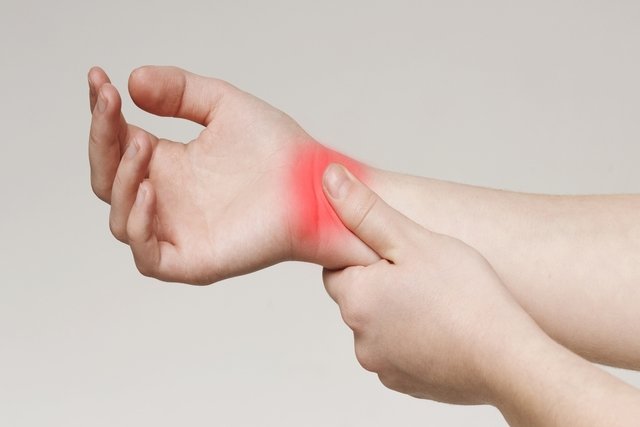Treatment for tendonitis can be done simply by resting the affected joint and applying an ice pack for about 20 minutes 3 to 4 times a day.
However, if it does not improve after a few days, it is important to consult an orthopedist so that a complete assessment can be carried out and the use of anti-inflammatory or analgesic medications and immobilization, for example, can be recommended.
In some cases, it may also be necessary to undergo physical therapy, which may use resources such as ultrasound, exercises or massage to treat tendon inflammation. In more serious cases, when it does not improve with the indicated treatment and physiotherapy or when the tendon ruptures, surgery may be recommended.

How the treatment is carried out
Treatment for tendinitis must be guided by an orthopedist, and may be recommended:
1. Tendinitis remedies
The main medications that may be indicated for tendonitis are:
- Anti-inflammatories and analgesics, for 7 to 10 days, to relieve pain and inflammation. Before taking the pill, it is also recommended to take a gastric protector, such as omeprazole, to protect the walls of the stomach, thus preventing gastritis caused by the medicines;
- Anti-inflammatory and analgesic ointmentswhich should be applied 3 to 4 times a day in the exact location of the pain, massaging lightly until the skin absorbs the product;
- Injectable corticosteroids, in cases where the use of anti-inflammatories is not sufficient, to more quickly relieve pain and inflammation. It is important that the injections are applied according to the doctor’s instructions, and 1 to 2 injections may be recommended with an interval of 4 to 6 months.
It is important that medications are used in accordance with the orthopedist’s instructions.
Make an appointment with the nearest orthopedist for more individualized guidance on the medications to be used:
Taking care of your health has never been easier!
2. Home remedies
A good home treatment for tendonitis is ice packs, as they help relieve pain and inflammation. To make ice packs, simply wrap some ice cubes in a thin towel, or diaper, making a small bundle and let it rest on the affected area for up to 20 minutes at a time.
Initially, this may cause some discomfort, but this should pass within approximately 5 minutes. This procedure can be performed approximately 3 to 4 times a day in the initial phase of treatment, in the first few days, and 1 or 2 times a day when symptoms subside. Check out some home remedy options for tendonitis.
3. Immobilization
Immobilization may be necessary in some situations, such as:
- There is increased sensitivity at the site;
- Pain only occurs when carrying out an activity, interfering with work, for example;
- There is swelling at the site;
- Muscle weakness.
Therefore, using a splint to immobilize the painful joint can help reduce movement, helping to alleviate pain and inflammation.
However, using the splint for a long time or frequently can weaken the muscles, which contributes to worsening tendonitis, so it is important to follow the orthopedist’s instructions.
4. Physiotherapy
Physiotherapy treatment for tendinitis can be done through resources such as ultrasound or ice packs, massages and stretching and muscle strengthening exercises to relieve pain and inflammation of the affected tendon and to maintain movement and strength of the affected muscles.
Ultrasound can be performed using the gel used for this equipment or with a mixture of this gel and an anti-inflammatory gel such as Voltaren. However, not all ointments can be used in this way, because they can prevent the penetration of ultrasound waves without having any effect.
Physiotherapy sessions can be carried out daily, 5 times a week, or according to the person’s availability. However, the closer one session is to the other, the better the results will be due to the cumulative effect.
5. Platelet-rich plasma
Platelet-rich plasma is a treatment that involves collecting a blood sample, which is then centrifuged to separate the platelets and then applied to the affected area to help the injured tissue recover faster, as platelets release substances known as growth factors.
6. Surgery for tendonitis
Surgery for tendinitis is indicated when other treatments have not been effective or when the tendon ruptures or calcium crystals are deposited in the area, making it necessary to scrape or sew the tendon after it ruptures.
The surgery is relatively simple and recovery does not take long. The person must spend around 5 to 8 days with a splint after surgery and after the doctor’s approval, the person can return to a few more physiotherapy sessions to recover completely.
How to prevent tendinitis from coming back
To prevent tendonitis from returning, it is important to find out what caused it. The causes vary from repetitive movements during the day, such as typing on the computer keyboard or cell phone several times a day, and holding a very heavy bag for more than 20 minutes, for example.
This type of excessive effort at once or constant injuries caused by repetitive movements lead to tendon inflammation and, consequently, localized pain near the joint.
Therefore, to cure tendonitis and not allow it to reappear, these situations must be avoided, taking breaks from work and avoiding excessive physical activity, for example. For those who work sitting, good posture at work is also important to prevent muscle contractures and joint overload.
Check out more tips for relieving tendinitis in the video below:




